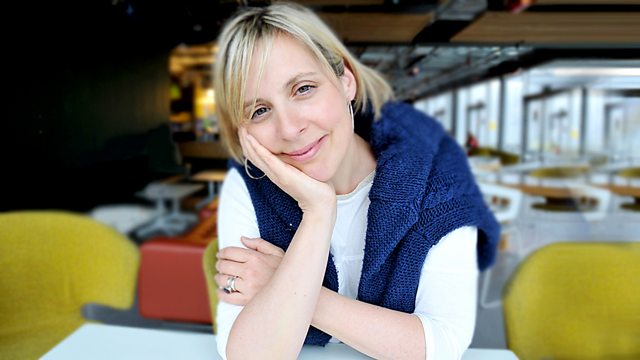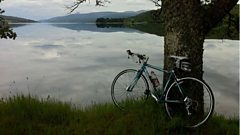
25/01/2013
Mel Giedroyc celebrates Burns Night with poems from Scotland's national bard. Plus the final chapter of the magical story, MM Kaye's 'The Ordinary Princess'.
Last on
Clip
-
![]()
Dick and Dom: Under Your Own Steam
Duration: 13:00
Chapters
-
How Dangerous is Your Journey
Dick and Dom fearlessly investigate journeys made under your own steam ...
Duration: 13:30
Robert Burns's iPod
David Owen Norris and guests go to Tarbolton to find out about the music of Robert Burns.
Duration: 05:40
Lavender Fields of Kent
Elinor Goodman goes to the lavender fields of Kent for 91�ȱ� Radio 4's 'On Your Farm'.
Duration: 04:40
Favourite Robert Burns Poems
The pupils of Loreburn Primary in Dumfries choose their favourite poems by Robert Burns.
Duration: 05:13
Mel's Magical Mystery Tour ...
Goes to Brighton Beach.
Duration: 05:35
The Ordinary Princess
The final episode of this week's story 'The Ordinary Princess' by MM Kaye.
Duration: 15:30
Activity 1: Balance and centres of gravity
You will need:
- A cork
- 2 forks
��
Take the cork, and try to balance it vertically on your nose.�� Can you manage? Now, take the forks, and stick them into the sides of the cork, so that they are hanging down on either side a bit like a penguin’s wings. Now try balancing the cork on your nose again. It should work this time!
��
What’s happening?
In order to balance, an object’s centre of gravity needs to be supported by something, otherwise it tips over and falls. When you add the forks, you are lowering the cork’s centre of gravity, making it more stable.��
All objects, including people, have a centre of gravity. Our centre of gravity is about where our belly button is.�� Try leaning over so your belly button is past your toes. Your centre of gravity isn’t supported, and you lose your balance.
��
Here’s another demonstration of how important your centre of gravity is. Stand straight, with your feet and knees together. Lift up your right leg. Did you notice you tilted your body to the left? This shifted your body’s centre of gravity and kept you balanced.
��
Now, lean your left side against a wall, so that your left foot, leg, and side are pushed right up against it. Make sure your feet are together. Try lifting your right leg. It’s impossible!�� The wall is stopping you from leaning over to shift your centre of gravity and balance.
Activity 2: Getting dizzy
It’s best to do this activity outside, on a soft grassy surface.
��
Another way to lose your balance is to get dizzy.�� In the programme, Dick and Dom have a race. Out in the garden, the scientists stuck a pole in the ground halfway down the lawn. The task was to run up to the marker, spin around ten times – and then try to walk back in a straight line. Because everyone was dizzy, that was really hard. When they tried to walk back with their eyes shut, it was even harder!�� What happens for you when you spin around to get dizzy, can you manage to walk?
��
What’s happening?
Keeping your balance and getting dizzy involves your ears. Inside your ears, there are hollow tubes full of fluid, called the semi-circular canals. If you tilt your head to one side, that fluid will move, helping your brain to work out that your head is tipped over. When you spin around, the fluid spins too. Have you ever spun a drink around in a cup? When you stop moving the cup, the liquid will carry on moving. That’s just what’s happening inside your ears, when you stop spinning – and that’s why you feel dizzy. Normally, your brain gets information from your eyes to help it work out where you are and how you are moving. But when you close your eyes, your brain uses the signals from your ears more, and that’s why walking in a straight line gets even harder!Activity 3: Friction and bicycle brakes
The brakes on a bicycle stop the wheels from turning. To do that, they use a force called friction. Friction happens when two surfaces touch each other. When you pull on a bicycle brake, the rubber pads of your brakes move so they are touching the rim of your wheel. That creates a lot of friction, which slows down the turning of the wheel until it stops.
��
You can see the power of friction for yourself, using two paperback books which are about the same size. Take the books, and place them so that they are facing each other, with the spines on the outside. Now, overlap the pages of books, so they are interlaced together: open at the first page of one book, and overlap it with a page from the second book, then overlap that with a page from the first book, and so on, until you’ve done the whole book. Push the books together as much as you can. Now, without wiggling the books from side to side, try to separate them. The friction between all the pages together is so strong, that it’s very difficult to pull them apart.
Broadcast
- Fri 25 Jan 2013 16:0091�ȱ� Radio 4 Extra

